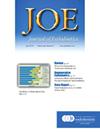Exploring Relationships Between Circulating Interleukins and Pulp and Periapical Diseases: A Bidirectional Mendelian Randomization Study
IF 3.5
2区 医学
Q1 DENTISTRY, ORAL SURGERY & MEDICINE
引用次数: 0
Abstract
Introduction
The aim of this study was to comprehensively evaluate the links of genetic predisposition among 13 common circulating interleukins (ILs) and endodontic diseases by using a 2-sample Mendelian randomization method.
Methods
Single nucleotide polymorphisms were chosen as instrumental variables from summary data of genome-wide association studies (GWASs), using the inverse-variance–weighted method as the primary analysis. In addition, a variety of sensitivity analyses was conducted to evaluate the resilience of the primary outcomes and identify any inherent pleiotropic effects.
Results
After multiple comparison corrections, 4 circulating ILs were genetically predicted to significantly play a role in endodontic diseases. Among these, circulating IL-17 (odds ratio [OR]IVW, 1.33; 95% confidence interval [CI], 1.15–1.54; P < 3.85 × 10−3) were significantly identified as potential risk-increasing factors toward pulp and periapical diseases, and circulating IL-16 (ORIVW, 0.89; 95% CI, 0.83 to 0.94; P < 3.85 × 10−3) may exert protective effects on the development of periapical abscess. In the reverse analyses, null significantly association was found between genetic liability to endodontics disorders and the corresponding circulating inflammatory biomarkers. Overall, sensitivity analyses were consistent with the estimates direction of primary analyses results, supporting the reliability of findings.
Conclusions
Given the unavoidable limitations presented in this study, our findings provided significant evidence to support the identification of elevated IL-16 levels as a potential risk-mitigating factor, whereas elevated IL-17 levels exhibit potentially deleterious effects on endodontic disorders. Future validation is warranted to examine the conclusions of our study and to evaluate the potential application of these circulating ILs as lifestyle or pharmacological targets for oral health care.
探索循环白细胞介素与牙髓和根尖周疾病之间的关系:一项双向孟德尔随机研究。
引言本研究旨在利用双样本孟德尔随机法全面评估13种常见循环白细胞介素(ILs)的遗传易感性与牙髓疾病的关系:从全基因组关联研究(GWAS)的汇总数据中选择单核苷酸多态性(SNPs)作为工具变量,采用逆方差加权法进行主要分析。此外,还进行了各种敏感性分析,以评估主要结果的适应性,并确定任何固有的多向效应:结果:经过多重比较校正后,有四种循环白细胞介素在牙髓疾病中具有显著的基因预测作用。其中,循环 IL-17 (ORIVW = 1.33; 95% CI, 1.15 to 1.54; P < 3.85×10-3)被显著鉴定为牙髓和根尖周疾病的潜在风险增加因素,而循环 IL-16 (ORIVW = 0.89; 95% CI, 0.83 to 0.94; P < 3.85×10-3)可能对根尖周脓肿的发生具有保护作用。在反向分析中,发现牙髓病遗传易感性与相应的循环炎症生物标志物之间无明显关联。总体而言,敏感性分析与主要分析结果的估计方向一致,证明了研究结果的可靠性:鉴于本研究中不可避免的局限性,我们的研究结果提供了重要的证据,支持将 IL-16 水平升高确定为潜在的风险缓解因素,而 IL-17 水平升高则对牙髓病有潜在的有害影响。未来有必要对我们研究的结论进行验证,并评估这些循环白细胞介素作为口腔保健的生活方式或药物目标的潜在应用。
本文章由计算机程序翻译,如有差异,请以英文原文为准。
求助全文
约1分钟内获得全文
求助全文
来源期刊

Journal of endodontics
医学-牙科与口腔外科
CiteScore
8.80
自引率
9.50%
发文量
224
审稿时长
42 days
期刊介绍:
The Journal of Endodontics, the official journal of the American Association of Endodontists, publishes scientific articles, case reports and comparison studies evaluating materials and methods of pulp conservation and endodontic treatment. Endodontists and general dentists can learn about new concepts in root canal treatment and the latest advances in techniques and instrumentation in the one journal that helps them keep pace with rapid changes in this field.
 求助内容:
求助内容: 应助结果提醒方式:
应助结果提醒方式:


